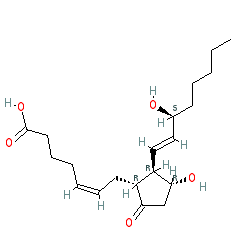|
Synonyms: [3H]-PGE2 | [3H]prostaglandin E2 | [3H]prostin E2
Compound class:
Synthetic organic
Ligand Activity Visualisation ChartsThese are box plot that provide a unique visualisation, summarising all the activity data for a ligand taken from ChEMBL and GtoPdb across multiple targets and species. Click on a plot to see the median, interquartile range, low and high data points. A value of zero indicates that no data are available. A separate chart is created for each target, and where possible the algorithm tries to merge ChEMBL and GtoPdb targets by matching them on name and UniProt accession, for each available species. However, please note that inconsistency in naming of targets may lead to data for the same target being reported across multiple charts. ✖ |
|
|||||||||||||||||||||||||||||||||||
| References |
|
1. Abramovitz M, Adam M, Boie Y, Carrière M, Denis D, Godbout C, Lamontagne S, Rochette C, Sawyer N, Tremblay NM et al.. (2000)
The utilization of recombinant prostanoid receptors to determine the affinities and selectivities of prostaglandins and related analogs. Biochim Biophys Acta, 1483 (2): 285-93. [PMID:10634944] |
|
2. Boie Y, Stocco R, Sawyer N, Slipetz DM, Ungrin MD, Neuschäfer-Rube F, Püschel GP, Metters KM, Abramovitz M. (1997)
Molecular cloning and characterization of the four rat prostaglandin E2 prostanoid receptor subtypes. Eur J Pharmacol, 340 (2-3): 227-41. [PMID:9537820] |
|
3. Chan BS, Satriano JA, Pucci M, Schuster VL. (1998)
Mechanism of prostaglandin E2 transport across the plasma membrane of HeLa cells and Xenopus oocytes expressing the prostaglandin transporter "PGT". J Biol Chem, 273 (12): 6689-97. [PMID:9506966] |
|
4. Davis TL, Sharif NA. (2000)
Pharmacological characterization of [(3)H]-prostaglandin E(2) binding to the cloned human EP(4) prostanoid receptor. Br J Pharmacol, 130: 1919-1926. [PMID:10952683] |
|
5. Nemoto K, Pilbeam CC, Bilak SR, Raisz LG. (1997)
Molecular cloning and expression of a rat prostaglandin E2 receptor of the EP2 subtype. Prostaglandins, 54 (4): 713-25. [PMID:9440134] |
|
6. Okuda-Ashitaka E, Sakamoto K, Ezashi T, Miwa K, Ito S, Hayaishi O. (1996)
Suppression of prostaglandin E receptor signaling by the variant form of EP1 subtype. J Biol Chem, 271 (49): 31255-61. [PMID:8940129] |
|
7. Sharif NA, Davis TL. (2002)
Cloned human EP1 prostanoid receptor pharmacology characterized using radioligand binding techniques. J Pharm Pharmacol, 54 (4): 539-47. [PMID:11999132] |
|
8. Sugimoto Y, Nakato T, Kita A, Takahashi Y, Hatae N, Tabata H, Tanaka S, Ichikawa A. (2004)
A cluster of aromatic amino acids in the i2 loop plays a key role for Gs coupling in prostaglandin EP2 and EP3 receptors. J Biol Chem, 279 (12): 11016-26. [PMID:14699136] |
|
9. Whittle BJ, Silverstein AM, Mottola DM, Clapp LH. (2012)
Binding and activity of the prostacyclin receptor (IP) agonists, treprostinil and iloprost, at human prostanoid receptors: treprostinil is a potent DP1 and EP2 agonist. Biochem Pharmacol, 84 (1): 68-75. [PMID:22480736] |
|
10. Wilson RJ, Giblin GM, Roomans S, Rhodes SA, Cartwright KA, Shield VJ, Brown J, Wise A, Chowdhury J, Pritchard S et al.. (2006)
GW627368X ((N-{2-[4-(4,9-diethoxy-1-oxo-1,3-dihydro-2H-benzo[f]isoindol-2-yl)phenyl]acetyl} benzene sulphonamide): a novel, potent and selective prostanoid EP4 receptor antagonist. Br J Pharmacol, 148 (3): 326-39. [PMID:16604093] |









